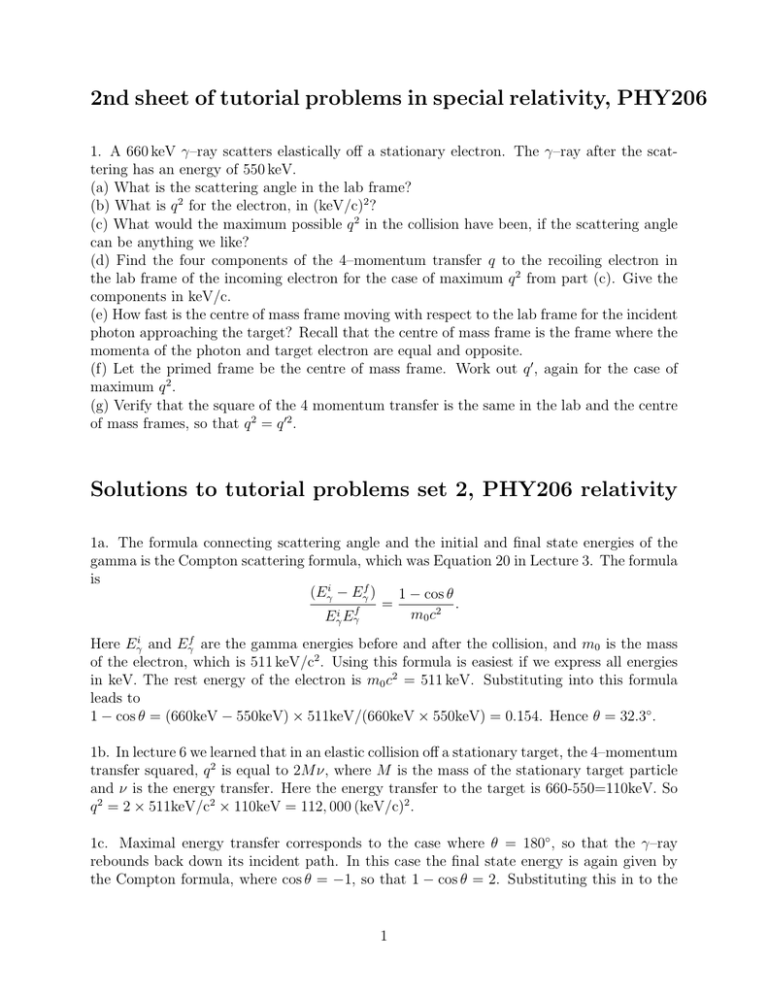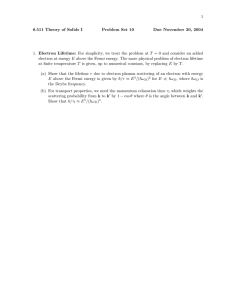Tutorial problems 2.
advertisement

2nd sheet of tutorial problems in special relativity, PHY206 1. A 660 keV γ–ray scatters elastically off a stationary electron. The γ–ray after the scattering has an energy of 550 keV. (a) What is the scattering angle in the lab frame? (b) What is q 2 for the electron, in (keV/c)2 ? (c) What would the maximum possible q 2 in the collision have been, if the scattering angle can be anything we like? (d) Find the four components of the 4–momentum transfer q to the recoiling electron in the lab frame of the incoming electron for the case of maximum q 2 from part (c). Give the components in keV/c. (e) How fast is the centre of mass frame moving with respect to the lab frame for the incident photon approaching the target? Recall that the centre of mass frame is the frame where the momenta of the photon and target electron are equal and opposite. (f) Let the primed frame be the centre of mass frame. Work out q 0 , again for the case of maximum q 2 . (g) Verify that the square of the 4 momentum transfer is the same in the lab and the centre of mass frames, so that q 2 = q 02 . Solutions to tutorial problems set 2, PHY206 relativity 1a. The formula connecting scattering angle and the initial and final state energies of the gamma is the Compton scattering formula, which was Equation 20 in Lecture 3. The formula is (Eγi − Eγf ) 1 − cos θ . = f i m 0 c2 Eγ Eγ Here Eγi and Eγf are the gamma energies before and after the collision, and m0 is the mass of the electron, which is 511 keV/c2 . Using this formula is easiest if we express all energies in keV. The rest energy of the electron is m0 c2 = 511 keV. Substituting into this formula leads to 1 − cos θ = (660keV − 550keV) × 511keV/(660keV × 550keV) = 0.154. Hence θ = 32.3◦ . 1b. In lecture 6 we learned that in an elastic collision off a stationary target, the 4–momentum transfer squared, q 2 is equal to 2M ν, where M is the mass of the stationary target particle and ν is the energy transfer. Here the energy transfer to the target is 660-550=110keV. So q 2 = 2 × 511keV/c2 × 110keV = 112, 000 (keV/c)2 . 1c. Maximal energy transfer corresponds to the case where θ = 180◦ , so that the γ–ray rebounds back down its incident path. In this case the final state energy is again given by the Compton formula, where cos θ = −1, so that 1 − cos θ = 2. Substituting this in to the 1 Compton formula and rearranging, we obtain Eγf = Eγi . 1 + 2Eγi /(m0 c2 ) Substituting into this we obtain Eγf = 660keV/(1 + 2 × 660keV/511keV) = 184keV. Therefore the energy transfer to the electron is ν = 660keV − 184keV = 476keV. Therefore, again using (qc)2 = 2M ν, we obtain q 2 = 2 × 511keV × 476keV/c2 = 486, 000(keV/c)2 . 1d. The energy transferred to the electron is already calculated - it’s 476keV. The momentum imparted to the electron is the difference between the initial and final state momenta of the γ–ray, which is 660keV/c - (-184keV/c) = 844 keV/c. Note the critical ‘-’ sign. Therefore, for the target electron, q = (476keV/c, 844keV/c, 0keV/c, 0keV/c). In the case of a head on collision, only the x–component of the momentum transfer is non–zero. 1e. Let the primed frame be the centre of mass frame. The Lorentz transformation for mo0 mentum is p0 = γ(p − βE/c). For the incoming γ–ray, this becomes piγ = γ(Eγi /c − βEγi /c). For the target electron, this becomes p0e = −βγm0 c, since in the unprimed frame the electron has initially stationary. Setting these momenta to be equal and opposite, we obtain βγm0 c = γ(Eγi /c − βEγi /c). We cancel the γ and arrive at βm0 c2 = Eγi − βEγi . Solving for β we arrive at β = E/(E +m0 c2 ), or in the case here β = 660keV/(660keV + 511keV) = 0.563.. So the centre of mass frame is moving at 0.563c to the right with respect to the lab frame. p 1f. For β = 0.563, we are in the mildly relativistic regime, hence γ = 1/ (1 − β 2 ) = 1.21. Therefore we transform q as follows: q 00 = γq 0 −βγq 1 = 1.21 × 476keV − 1.21 × 0.563 × 844keV, or q 00 = 1.0keV. For the 1st component, q 01 = γq 1 −βγq 0 = 1.2(844keV − 0.563 × 476keV) = 697keV. Therefore we have q 0 = (1keV/c, 697keV/c, 0keV/c, 0keV/c). 1g. The square of q is −4762 + 8442 = 486, 000 (keV/c)2 . The square of q 0 is −12 + 6972 = 486, 000 (keV/c)2 . This verifies that q 2 = q 02 . 2

